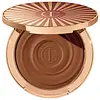Charlotte Tilbury Beautiful Skin Sun-Kissed Glow Bronzer Versus Patrick Ta Major Sculpt Creme Contour & Powder Bronzer Duo
What's inside
What's inside
 Key Ingredients
Key Ingredients

 Benefits
Benefits

 Concerns
Concerns

 Ingredients Side-by-side
Ingredients Side-by-side

Dimethicone
EmollientTriethylhexanoin
MaskingCeresin
Emulsion StabilisingPolymethylsilsesquioxane
Dimethicone Crosspolymer
Emulsion StabilisingTrimethylsiloxysilicate
EmollientPolyethylene
AbrasiveDimethicone/Polyglycerin-3 Crosspolymer
CleansingSilica
AbrasiveMica
Cosmetic Colorant7-Dehydrocholesterol
Emulsion StabilisingC10-18 Triglycerides
EmollientSodium Hyaluronate
HumectantTriolein
Skin ConditioningGlyceryl Dioleate
EmollientDipropylene Glycol
HumectantSodium Citrate
BufferingTocopherol
AntioxidantCI 77891
Cosmetic ColorantIron Oxides
Dimethicone, Triethylhexanoin, Ceresin, Polymethylsilsesquioxane, Dimethicone Crosspolymer, Trimethylsiloxysilicate, Polyethylene, Dimethicone/Polyglycerin-3 Crosspolymer, Silica, Mica, 7-Dehydrocholesterol, C10-18 Triglycerides, Sodium Hyaluronate, Triolein, Glyceryl Dioleate, Dipropylene Glycol, Sodium Citrate, Tocopherol, CI 77891, Iron Oxides
Mel Powder
AbrasiveAluminum Starch Octenylsuccinate
AbsorbentMagnesium Myristate
Octyldodecyl Stearoyl Stearate
EmollientPentaerythrityl Tetraisostearate
EmollientSilica
AbrasiveCaprylic/Capric Triglyceride
MaskingBis-Diglyceryl Polyacyladipate-2
EmollientSimmondsia Chinensis Seed Oil
EmollientTocopheryl Acetate
AntioxidantSynthetic Fluorphlogopite
Calcium Aluminum Borosilicate
Calcium Sodium Borosilicate
Sodium Dehydroacetate
PreservativePhenoxyethanol
PreservativeTropolone
Skin ConditioningTin Oxide
AbrasiveCI 77891
Cosmetic ColorantCI 77491
Cosmetic ColorantCI 77742
Cosmetic ColorantCI 77007
Cosmetic ColorantCI 77510
Cosmetic ColorantCI 42090
Cosmetic ColorantCI 19140
Cosmetic ColorantCI 15850
Cosmetic ColorantEthylhexyl Palmitate
EmollientTalc
AbrasivePolymethyl Methacrylate
Behenyl Beeswax
Skin ConditioningCopernicia Cerifera Cera
EmollientOzokerite
Emulsion StabilisingPolyethylene
AbrasiveStearyl Beeswax
EmollientHelianthus Annuus Seed Cera
EmollientAscorbyl Palmitate
AntioxidantTocopherol
AntioxidantHydrogen Dimethicone
Aluminum Hydroxide
EmollientMica
Cosmetic ColorantParfum
MaskingLimonene
PerfumingMel Powder, Aluminum Starch Octenylsuccinate, Magnesium Myristate, Octyldodecyl Stearoyl Stearate, Pentaerythrityl Tetraisostearate, Silica, Caprylic/Capric Triglyceride, Bis-Diglyceryl Polyacyladipate-2, Simmondsia Chinensis Seed Oil, Tocopheryl Acetate, Synthetic Fluorphlogopite, Calcium Aluminum Borosilicate, Calcium Sodium Borosilicate, Sodium Dehydroacetate, Phenoxyethanol, Tropolone, Tin Oxide, CI 77891, CI 77491, CI 77742, CI 77007, CI 77510, CI 42090, CI 19140, CI 15850, Ethylhexyl Palmitate, Talc, Polymethyl Methacrylate, Behenyl Beeswax, Copernicia Cerifera Cera, Ozokerite, Polyethylene, Stearyl Beeswax, Helianthus Annuus Seed Cera, Ascorbyl Palmitate, Tocopherol, Hydrogen Dimethicone, Aluminum Hydroxide, Mica, Parfum, Limonene
Ingredients Explained
These ingredients are found in both products.
Ingredients higher up in an ingredient list are typically present in a larger amount.
Ci 77891 is a white pigment from Titanium dioxide. It is naturally found in minerals such as rutile and ilmenite.
It's main function is to add a white color to cosmetics. It can also be mixed with other colors to create different shades.
Ci 77891 is commonly found in sunscreens due to its ability to block UV rays.
Learn more about CI 77891Mica is a naturally occurring mineral used to add shimmer and color in cosmetics. It can also help improve the texture of a product or give it an opaque, white/silver color.
Serecite is the name for very fine but ragged grains of mica.
This ingredient is often coated with metal oxides like titanium dioxide. Trace amounts of heavy metals may be found in mica, but these metals are not harmful in our personal products.
Mica has been used since prehistoric times throughout the world. Ancient Egyptian, Indian, Greek, Roman, Aztec, and Chinese civilizations have used mica.
Learn more about MicaPolyethylene is a synthetic ingredient that helps the skin retain moisture. It is a polymer.
It is also typically used within product formulations to help bind solid ingredients together and thicken oil-based ingredients. When added to balms and emulsions, it helps increase the melting point temperature.
Silica, also known as silicon dioxide, is a naturally occurring mineral. It is used as a fine, spherical, and porous powder in cosmetics.
Though it has exfoliant properties, the function of silica varies depending on the product.
The unique structure of silica enhances the spreadability and adds smoothness, making it a great texture enhancer.
It is also used as an active carrier, emulsifier, and mattifier due to its ability to absorb excess oil.
In some products, tiny microneedles called spicules are made from silica or hydrolyzed sponge. When you rub them in, they lightly polish away dead skin layers and enhance the penetration of active ingredients.
Learn more about SilicaTocopherol (also known as Vitamin E) is a common antioxidant used to help protect the skin from free-radicals and strengthen the skin barrier. It's also fat soluble - this means our skin is great at absorbing it.
Vitamin E also helps keep your natural skin lipids healthy. Your lipid skin barrier naturally consists of lipids, ceramides, and fatty acids. Vitamin E offers extra protection for your skin’s lipid barrier, keeping your skin healthy and nourished.
Another benefit is a bit of UV protection. Vitamin E helps reduce the damage caused by UVB rays. (It should not replace your sunscreen). Combining it with Vitamin C can decrease sunburned cells and hyperpigmentation after UV exposure.
You might have noticed Vitamin E + C often paired together. This is because it is great at stabilizing Vitamin C. Using the two together helps increase the effectiveness of both ingredients.
There are often claims that Vitamin E can reduce/prevent scarring, but these claims haven't been confirmed by scientific research.
Learn more about Tocopherol